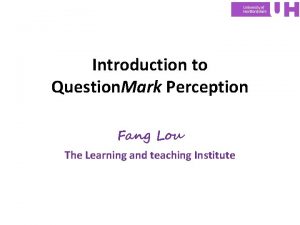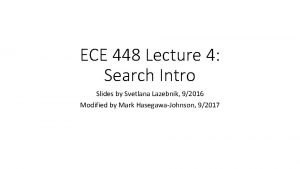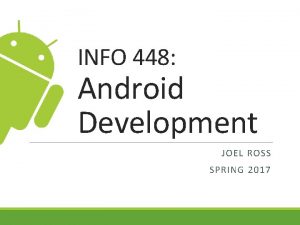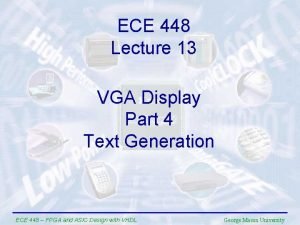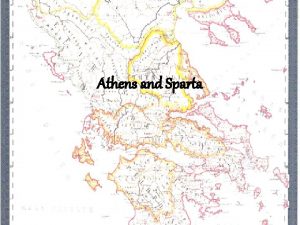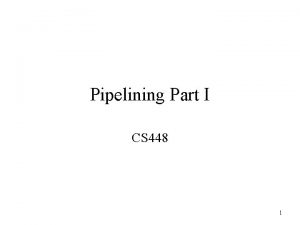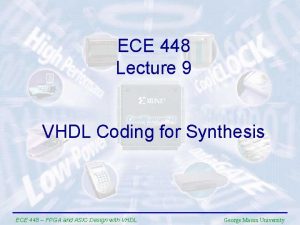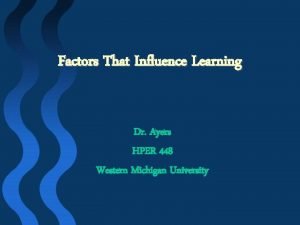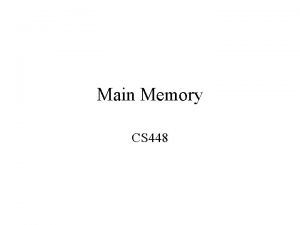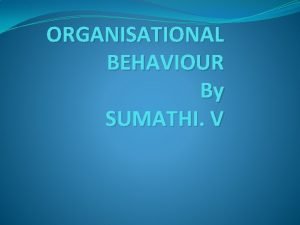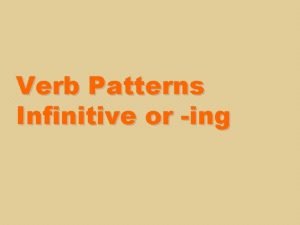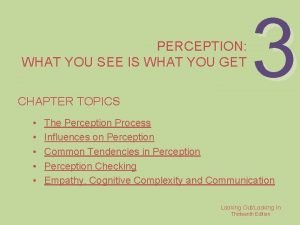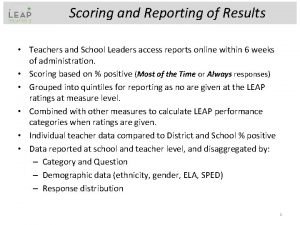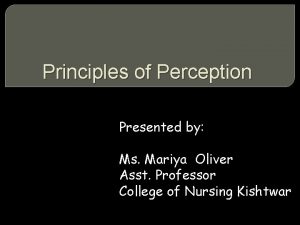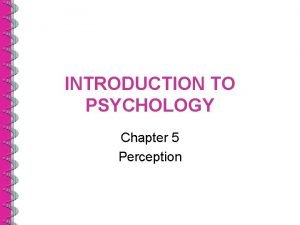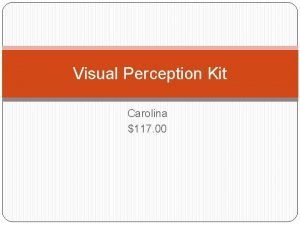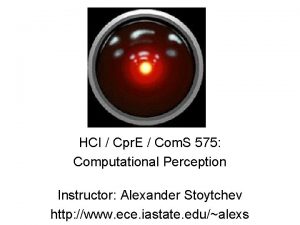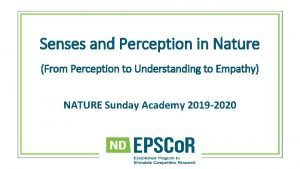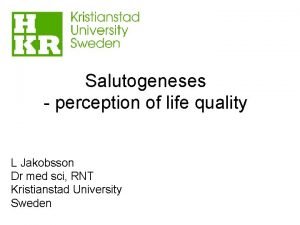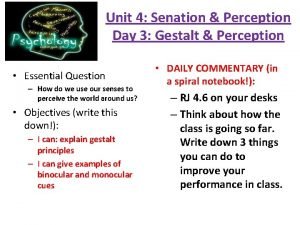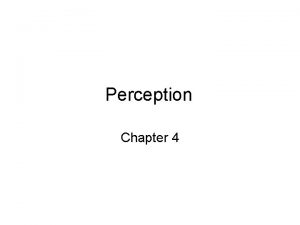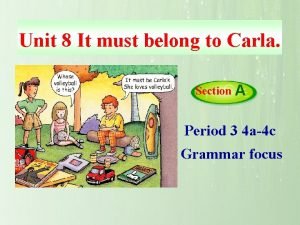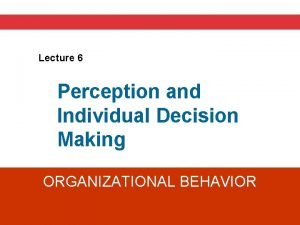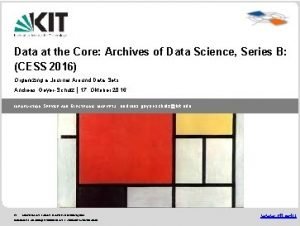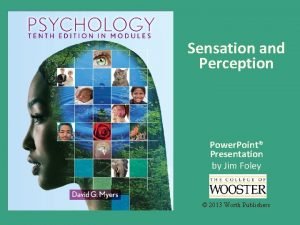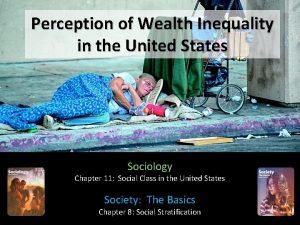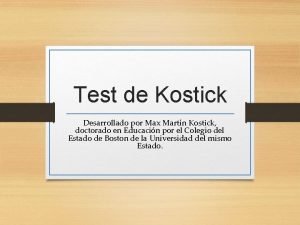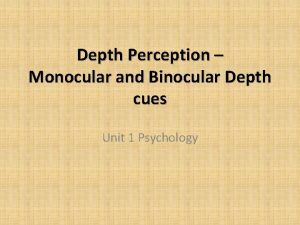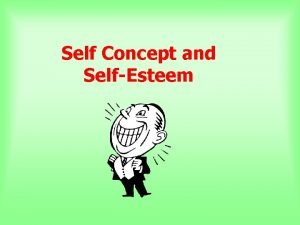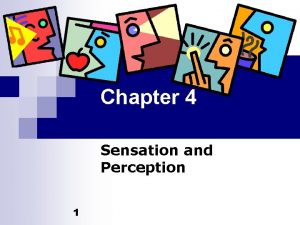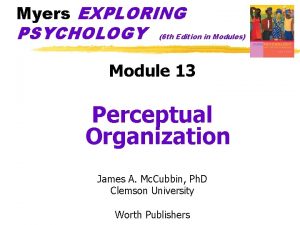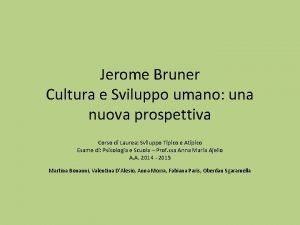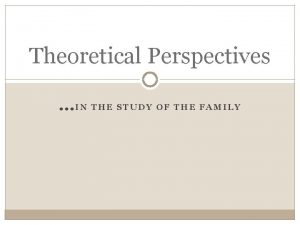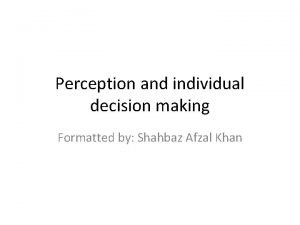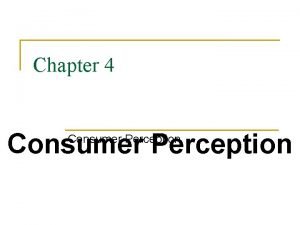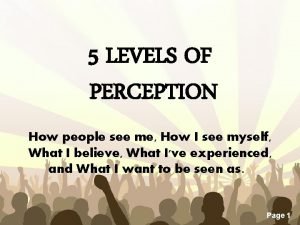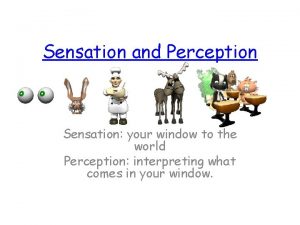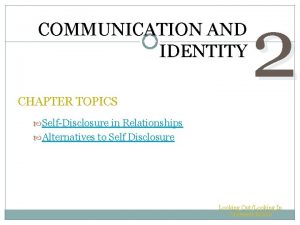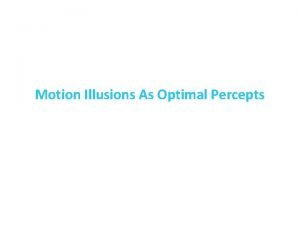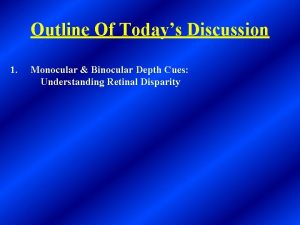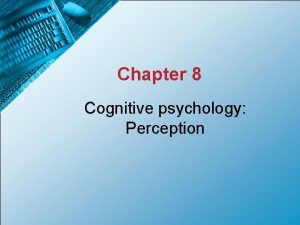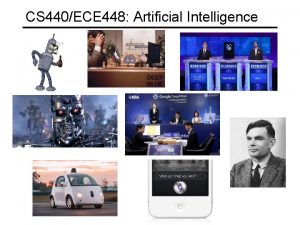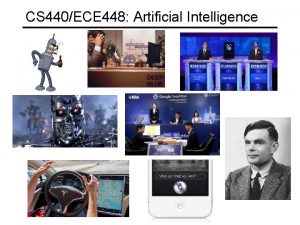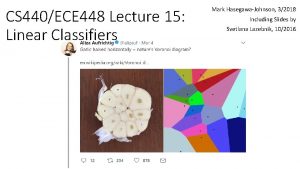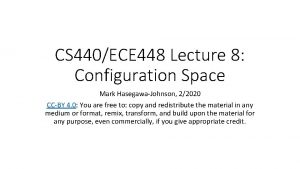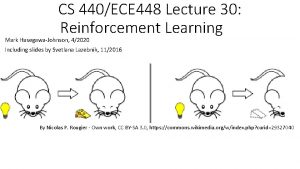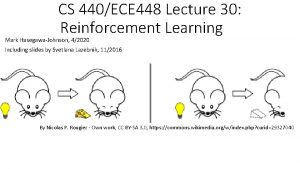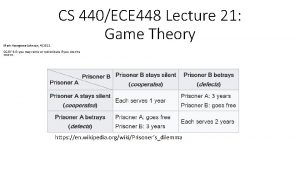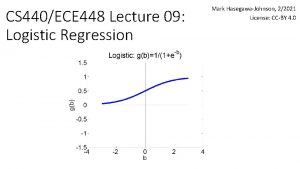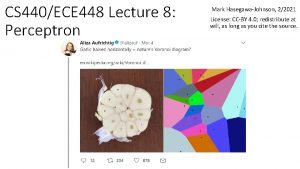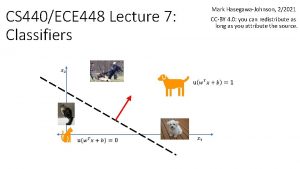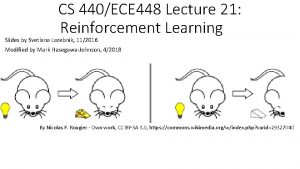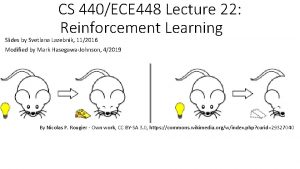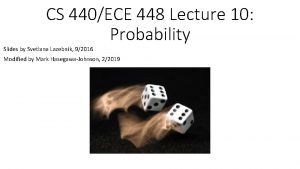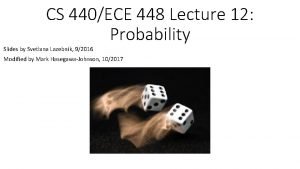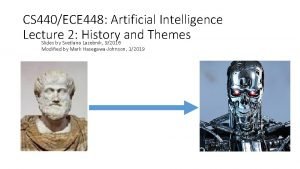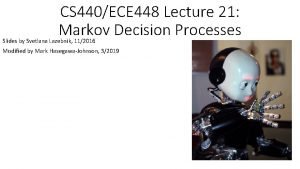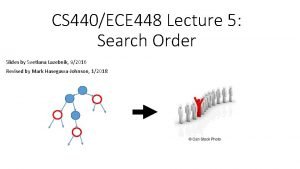CS 440ECE 448 Lecture 25 Perception 4232018 Mark






















































- Slides: 54

CS 440/ECE 448 Lecture 25: Perception 4/23/2018 Mark Hasegawa-Johnson

Perception • Web Texts • Sentiment Analysis; Information Retrieval; Information Extraction • Speech and Natural Language Processing • Parsing; Machine Translation; Speech Recognition • Computer Vision • Motion Vectors; Object Recognition; Object Localization; image 2 speech

Sentiment Analysis (Textbook section 22. 2: Text Classification) Image source: John Cawley, Data Analysts, 5/20/2017 https: //www. quora. com/Who-are-the-leadingproviders-of-sentiment-analysis-for-social-mediadata-and-which-companies-use-them-versusdeveloping-their-own-technology

Sentiment Analysis • Objective: automatically troll the internet to find out if people like or dislike your product. • Methods: • • Recognize keywords Stemming --- convert different morphological forms to the same root Tokenization --- merge phrases like “White House” into single words Partial parsing, to handle negation • Examples: from Wikipedia • Easy: ”Pastel-colored 1980 s day cruisers from Florida are ugly. ” • Hard: “I love my mobile but would not recommend it to my colleagues. ”

Sentiment Analysis: an online demo, with partial source code

Perception • Web Texts • Sentiment Analysis; Information Retrieval; Information Extraction • Speech and Natural Language Processing • Parsing; Machine Translation; Speech Recognition • Computer Vision • Optical Flow; Object Recognition; Object Detection; image 2 speech

Information Retrieval Textbook section 22. 3; CS 410, 510 • Given: • A corpus of documents • A query posed in some query language • Generate: • A list of results, usually rank-ordered • In order to maximize: • Some measure of utility

IR Measures of Utility • Is there any relevant document on the first page? • Precision at N = (# correct documents in the first N)/N • How many of the target documents did I get? • Recall at N = (# correct documents in first N)/(# correct in the database) • How far do I have to search in order to find the correct document? • Expected reciprocal rank = E [ 1/n ], where n = rank of the correct document

TF-IDF (term freq -inverse document freq) Karen Sparck Jones, 1972 •

Page. Rank (Brin and Page, 1998) •

Perception • Web Texts • Sentiment Analysis; Information Retrieval; Information Extraction • Speech and Natural Language Processing • Parsing; Machine Translation; Speech Recognition • Computer Vision • Motion Vectors; Object Recognition; Object Detection; image 2 speech

Information Extraction Text Section 22. 4; CS 412, 512 • Pattern recognition • Ontology extraction • Attribute extraction

Pattern Matching in text: Regular Expressions • Invented by Stephen Cole Kleene in the 1950 s • Just three basic operators: • + --- union of two sub-languages • x --- concatenation of two sub-languages • * --- zero or more repetitions of a sub-language • This expression contains (two|several) (very)* useful examples. • • This expression contains several very useful examples. This expression contains two useful examples.

Ontology Extraction: Entity Discovery and Linking Slide credit: Heng Ji 13岁以前的杨丽萍,是云南 一个山村小镇里光着脚丫到 处拾麦穗的乡下小姑娘,在 洱海之源过着艰苦而又不无 乐趣的童年生活。 Now, Ms. Yang, one of China's best-known dancers, is the director, choreographer and star of … KB Liping Yang Aunque nacida en Dali, a la edad de nueve años Yang se mudó con su familia a Xishuangbanna. Debido a su extraordinario talento, la eligieron para integrar la Agrupación Artística de Canto … … Liping Yang • Cross-lingual knowledge fusion: For certain entities and events, new and detailed information is only available in low-resource foreign incident languages • Cross-lingual Knowledge transfer: Build cross-lingual links to transfer resources (e. g. , annotated data, gazetteers and rich knowledge representations) from English to foreign language EDL

Attribute Extraction: Combine with Tri-lingual KBSlot Filling • Slide Credit: Heng Ji Each query = an entity cluster of multi-lingual mentions, with type, KB ID, and each mention’s Document ID, offsets Source Collection State/Province-of-Residence: 云南 13岁以前的杨丽萍,是云南一个山村小镇里光着脚丫到处拾麦穗的 乡下小姑娘,在洱海之源过着艰苦而又不无乐趣的童年生活。十几 年后,她摇身一变,成为舞台 上最绚丽的“孔雀”…而关于杨丽 萍的感情问题,曾经有个爆料人称,杨丽萍的前夫是中央民 族歌 舞团里的才子,一直帮着杨丽萍策划舞蹈,但后来,一个叫做托尼 的美籍台湾人(刘淳晴)出现后,把杨丽萍给撬走了。 Spouse: 刘淳晴 Title: dancer, director, choreographer Now, Ms. Yang, one of China's best-known dancers, is the director, choreographer and star of a new show that is drawing sellout crowds all over the country.

Perception • Web Texts • Sentiment Analysis; Information Retrieval; Information Extraction • Speech and Natural Language Processing • Parsing; Machine Translation; Speech Recognition • Computer Vision • Motion Vectors; Object Recognition; Object Detection; image 2 speech

Morphology: What is a word? • Most morphological rules can be written as Regular Expressions (e. g. , English pluralization), but some are less regular than others: (example: Harald Trost) • The rules, and the exceptions, are usually learned by expectation maximization from dictionaries, e. g. , https: //github. com/Adolf. Von. Kleist/Phonetisaurus • …but in some interesting & influential cases, large parsers are constructed by hand, e. g. , https: //catalog. ldc. upenn. edu/ldc 2004 l 02

Syntax: What is a sentence? Textbook section 23. 1 -3 By Tjo 3 ya - Own work, CC BY-SA 3. 0, https: //commons. wikimedia. org/w/index. php? curid=18436919

Syntax example: the Stanford Parser

Parsing: UIUC courses • CS 447, Natural Language Processing • CS 546, Machine Learning in Natural Language Processing • LING 406, Computational Linguistics • LING 506, Computational Linguistics

Machine Translation Textbook section 23. 4; UIUC course LING 415, Machine Translation • Includes two processes: word reordering + word translation By Krz. wolk - Own work, CC BY-SA 4. 0, https: //commons. wikimedia. org/w/index. php? curid=44522757

Perception • Web Texts • Sentiment Analysis; Information Retrieval; Information Extraction • Speech and Natural Language Processing • Parsing; Machine Translation; Speech Recognition • Computer Vision • Motion Vectors; Object Recognition; Object Detection; image 2 speech

3 steps to produce sounds Slide credit: Odette Scharenborg step 3: articulation = distortion of air à time-varying formant-frequency Filter pattern = speech step 2: phonation step 1: initiation Source

Speech signal: Time domain Slide credit: ECE 417 /k/ burst /k/ aspiration voicing

Speech signal: Log Magnitude Transform Slide credit: ECE 417

Spectrogram: One spectral vector every 10 ms Slide credit: ECE 590 SIP

Recognition: Hidden Markov Model Source: Mark Hasegawa-Johnson, ECE 417 Source: By Tdunningvectorization: Own work, CC BY 3. 0, https: //commons. wikimedia. org/w/index. php? cur id=18125206

Speech Processing: UIUC courses Textbook section 23. 5 • ECE 417: Multimedia Signal Processing (Speech & Video) • ECE 537: Speech Processing • ECE 594: Mathematical Models of Language • CS 598 PS: Machine Learning for Signal Processing

Perception • Web Texts • Sentiment Analysis; Information Retrieval; Information Extraction • Speech and Natural Language Processing • Parsing; Machine Translation; Speech Recognition • Computer Vision • Motion Vectors; Object Recognition; Object Detection; image 2 speech

Motion Vectors Textbook section 24. 2. 3; ECE 417 •


By German iris – Own work, CC BY-SA 4. 0, https: //commons. Wikimedia. org/w/index. php? curid=472




Perception • Web Texts • Sentiment Analysis; Information Retrieval; Information Extraction • Speech and Natural Language Processing • Parsing; Machine Translation; Speech Recognition • Computer Vision • Motion Vectors; Object Recognition; Object Localization; image 2 speech

Object Recognition Textbook chapter 24; CS 446, 549 • Now a classic problem in machine learning, thanks to big databases like imagenet • Basically: given an input image, try to say what type of object is most visible in the input image




Perception • Web Texts • Sentiment Analysis; Information Retrieval; Information Extraction • Speech and Natural Language Processing • Parsing; Machine Translation; Speech Recognition • Computer Vision • Motion Vectors; Object Recognition; Object Localization; image 2 speech

Face Detection Slide credit: ECE 417 rects. txt: 12 rectangles per line: lips, face, other 4 ints/rectangle: [xmin, ymin, width, height] showrects. m plots Yellow: lips (first 4/line) Cyan: face (next 4/line) Red: other (next 4/line) MP: Discriminate face vs. other

Example features: order 2, horizontal Feature f(x; fr, q=2, v=0) An order-2 horizontal feature is the sum of the right half, minus the sum of the left half.

Other useful features: order 3, vertical Feature f(x; fr, q=3, v=1) An order-3 vertical feature is the sum of the outer thirds, minus the sum of the middle third.

Adaboost •

I-Vector Object Detectors

Perception • Web Texts • Sentiment Analysis; Information Retrieval; Information Extraction • Speech and Natural Language Processing • Parsing; Machine Translation; Speech Recognition • Computer Vision • Motion Vectors; Object Recognition; Object Localization; image 2 speech

How many languages are there in the world? • According to ethnologue, there are 6900 languages. Methods of writing have been invented for about 4000 of them. • There are 206 countries in the world, of which 193 have an official language; 101 have more than one. There are no figures on the number of different “official” languages, but maybe it is 300 languages. • So the number of distinct languages in which children are taught to READ and WRITE (as opposed to just speaking) is about 300. • All of the other 6900 – 300 = 6600 languages (dialects; codes) are purely spoken: a writing system may exist, but is rarely used.

Image 2 speech = img 2 txt + TTS - text • If there is no writing system, then speech is the only communication tool, but: Must one speak in Modern Standard Arabic to be understood by one’s cell phone? • Task Definition: Can we develop speech technology in a dialect that is almost never written down in any standardized text format? Definition: An image 2 speech algorithm is an algorithm that observes an image, and generates a spoken description of the image, without requiring that the language of the description has any standardized text format.

Datasets • AMT recordings obtained from Flickr 8 k - 40 k spoken captions available online (Julia Hockenmaier et al. , 2009) • • https: //groups. csail. mit. edu/sls/downloads/ D. Harwath and J. Glass, “Deep multimodal semantic embeddings for speech and images” in IEEE ASRU, Scottsdale, Arizona, USA, December 2015 -A brown and white dog is running through the snow -A dog is running in the snow -A dog running through snow -A white and brown dog is running through a snow covered field -The white and brown dog is running over the surface of the snow 50

• Image. Net = >500 images/noun of each of the nouns in Word. Net. • VGG = 13 -layer CNN + 2 -layer FCN, trained on 14 m images, covering the 1000 most numerous nouns, 92. 7% top-5 test accuracy. • CNNFEAT: 196 feature vectors/image, 512 d/vector, from the last CNN layer. Each receptive field covers about 40 x 40 pixels in the original 224 x 224 image. • VGGFEAT (used later in today’s talk, not right now): 1 vector/image, 4096 d/vector, from penultimate FCN layer Figure copied from Simonyan & Zisserman, 2014.

im 2 ph: phones from images Figure copied without permission from Duong, Anastasopoulos, Chiang, Bird & Cohn, NAACL-HLT 2016. l “Representation: ” 196 vectors/image l “Encoder: ” Pyramidal. LSTM with one 128 d state vector. Sequence is row-wise raster scan of the image. l “Attention: ” Standard. Attender, 128 d input, 128 d state vector, N hidden nodes l “Decoder: ” Mlp. Softmax. Decoder, 3 layers, 1024 d hidden vectors l Output vocabulary: synthetic phones (MSCOCO), force-aligned phones (flickr 8 k), or acoustic unit discoveries (both)

flickr 8 K: American phones l Reference 1: “The boy +um+ laying face down on a skateboard is being pushed along the ground by +laugh+ another boy. ” l Reference 2: “Two girls +um+ play on a skateboard +breath+ in a court +laugh+ yard. ” l Hypothesis (128 d attender): SIL +BREATH+ SIL T UW M EH N AA R R AY D IX NG AX R EH D AE N W AY T SIL R EY S SIL l Hypothesis (64 d attender): SIL +BREATH+ SIL T UW W IH M AX N W AO K IX NG AA N AX S T R IY T SIL l Reference 1: “A boy +laugh+ in a blue top +laugh+ is jumping off some rocks in the woods. ” l Reference 2: “A boy +um+ jumps off a tan rock. ” l Hypothesis (128 d attender): SIL +BREATH+ SIL EY M AE N IH Z JH AH M P IX NG IH N DH AX F AO R EH S T SIL l Hypothesis (64 d attender): SIL +BREATH+ SIL EY Y AH NG B OY W EY R IX NG AX B L UW SH ER T SIL IH Z R AY D IX NG AX HH IH L SIL Images and Reference Texts: Hodosh, Young & Hockenmaier, 2013. Waveforms: Harwath and Glass, 2015

Perception • Web Texts • Sentiment Analysis; Information Retrieval; Information Extraction • Speech and Natural Language Processing • Parsing; Machine Translation; Speech Recognition • Computer Vision • Motion Vectors; Object Recognition; Object Localization; image 2 speech
 01:640:244 lecture notes - lecture 15: plat, idah, farad
01:640:244 lecture notes - lecture 15: plat, idah, farad Question mark perception
Question mark perception Ece448
Ece448 Ece 448
Ece 448 Info 448
Info 448 Ece 448
Ece 448 448 scmw
448 scmw Ece 448
Ece 448 500-448
500-448 Cs 448
Cs 448 Jest głównym dopływem wisły ma 448 km długości
Jest głównym dopływem wisły ma 448 km długości Fpga software
Fpga software Ece 448
Ece 448 Factors of 448
Factors of 448 Cs 448
Cs 448 Importance of organisational behaviour
Importance of organisational behaviour Verbs of perception + infinitive/-ing form
Verbs of perception + infinitive/-ing form What does the word perception mean
What does the word perception mean Define perception checking
Define perception checking Student perception survey dps
Student perception survey dps Principle of context
Principle of context Perceptual set ap psych
Perceptual set ap psych Motion parallax definition psychology
Motion parallax definition psychology Carolina visual perception kit
Carolina visual perception kit Perception hci
Perception hci Nature of perception
Nature of perception Perception
Perception Intermodal perception
Intermodal perception Relative size gestalt
Relative size gestalt Approaches to perception
Approaches to perception Perception
Perception Copyright
Copyright Perception and individual decision making
Perception and individual decision making Perception checking process
Perception checking process The perception process
The perception process Process of perception
Process of perception Perception vs sensation
Perception vs sensation Perception of wealth
Perception of wealth Perception and preference inventory
Perception and preference inventory What is sensation and perception
What is sensation and perception Monocular pictorial depth cues
Monocular pictorial depth cues Self concept vs self esteem
Self concept vs self esteem Perception gestalt principles
Perception gestalt principles Depth perception
Depth perception Cassetta degli attrezzi bruner
Cassetta degli attrezzi bruner Perspective vs perception
Perspective vs perception Example of perception
Example of perception Consumer perception definition
Consumer perception definition Levels of perception
Levels of perception Webers law
Webers law Eudemonistic model of health
Eudemonistic model of health Perception checking process
Perception checking process Perception
Perception Crossed disparity
Crossed disparity Conclusion of perception
Conclusion of perception

